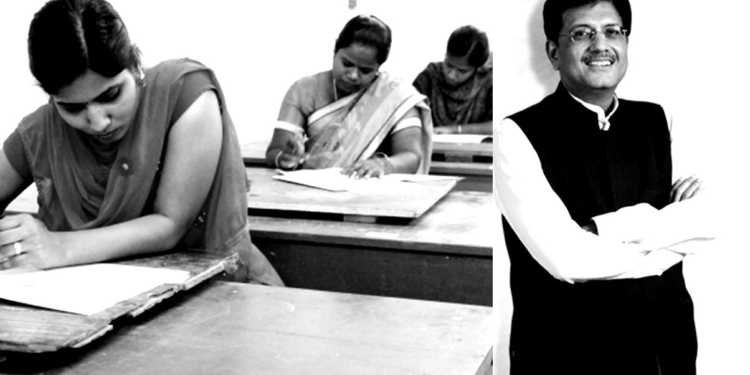Congress member of Parliament Ranjeet Ranjan had on Monday alleged that the government is doing injustice to the aspirants of Railway Recruitment Board (RRB) online exams. It was alleged by the legislator that the aspirants are being sent to far-flung areas to appear in the examinations. The Lok Sabha member from Supaul in Bihar was speaking during Zero Hour in the Lower House. He said, “RRB examination is to be held on August 9. And the Railway Ministry is arranging seats of many candidates far from their house, as well as their respective states.” She said that applicants from Bihar are being made to write examinations in Hyderabad, aspirants from Buxar are being sent to Chennai, while the aspirants from Patna are being sent to Bengaluru. This is the biggest recruitment exercise anywhere in the world. A record number of candidates have applied for the posts of Assistant Loco Pilots (ALPs) and Technicians. It seems that the Congress leader did not keep these facts in mind before making this casual statement about alleged injustice to the candidates.
However, these allegations and barbs made by the Congress have fallen flat on their face. The fact remains that this is the single recruitment exercise to have ever taken place on the planet. Around 2.27 crore candidates are going to appear for this examination. However, even after conducting an examination of such huge magnitude, the government and the Indian Railways have taken utmost care to ensure the welfare of the candidates and that no injustice is done to anyone of them. The government has adopted an extensive methodology to ensure that candidates are not made to appear in far-flung areas away from their hometowns.
Firstly, there has been a landmark reform in the way examination centres have been allotted this time around. Earlier, examinations used to take place separately for each railway zone. Therefore, if a candidate belonging to the state of Jammu & Kashmir had to appear in an examination for recruitment in the southern zone, he was required to travel all the way from his hometown in Jammu & Kashmir to Chennai or some other place in southern India for appearing in the exam. However, now the examinations are being conducted together for all the zones and thus the same candidate from Jammu & Kashmir can apply for the southern zone and can appear for exam near his native place.
Secondly, the Indian Railways has been extremely cautious and stringent with the selection of examination centres. Stakes are high with a record number of candidates appearing for the examination and the Railways is dead serious about not allowing any malpractice to take place. This is not only an online test which is a great leap forward but all security precautions have been taken including necessary facilities like CCTVs, secure internet connection, etc. Lastly, as stated above this is the biggest recruitment exercise anywhere in the world. Naturally in some of the states, the number of candidates is in excess of what the local infrastructure in the concerned state can accommodate. Despite a conscious effort by the Indian Railways to allot the nearest possible centre to the candidates, in such cases centres in other states had to be allotted. However, in this case also the Railways have followed a sound recruitment policy and have made sure that centres are allotted to the candidates in the most reasonable manner. The standard procedure followed in allotment of centres has been to allot all women and physically disabled persons nearby centres.
Thus, 99% of the women and physically disabled candidates have been allotted centres within a radius of 200 km. In case of male candidates, the nearby centres were allotted in a fair and reasonable way on first come first serve basis. Therefore, there was no question of discrimination or nepotism and a uniform and sound policy was followed. Other candidates who could not be allotted nearby centres were allotted centres in the adjoining states. Only after all these options were exhausted, the Railways allotted centres further away. However, in such cases also care was taken to ensure that such candidates were allotted centres in metro cities and not remote areas in order to facilitate ease of travel and accommodation. It has also been learnt that special trains have been arranged to aid the candidates in their travel to the examination centres. Understanding the sentiments of the aspirants, e mails were also sent by the Railway Recruitment Board to the candidates in order to apprise them of the crucial steps taken in conducting the online examination.
Statistics also concur with the above methodology. The claim by the Congress MP that most of the candidates have been allotted far flung centres stands negated. The fact remains that 54% of the candidates were allotted centres within 100 kilometres radius. 73.5 % aspirants were allotted centres within 250 kilometres radius and 83 % of the total candidates were allotted centres within a radius of 500 kilometres. Only 17% of the candidates have been allotted centres beyond the radius of 500 kilometres. Almost all women and physically disabled candidates were allotted centres within a radius of 200 kilometres.
The argument that the exam should have been postponed is also a flawed and senseless argument, especially when train operations are being hampered due to the paucity of ALPs which is a very critical post in the railways. Furthermore, the recruitment to the posts of ALPs and technicians is going to be immediately followed by recruitment to Level-I posts of Trackmen, Traffic porters, etc. It is yet another mammoth recruitment exercise and around 1.9 crore candidates will be giving that exam. The Indian Railways therefore cannot delay the ongoing process of recruitment. The claim that candidates have not been able to travel to distant centres leading to a large number of candidates not being able to give the Exam is also a mere figment of imagination.
The Indian Railways have gone the extra mile to ensure that candidates are able to transverse easily to the examination centres. For this purpose, 36 ‘Exam special’ trains were also run between different exam centres. This is further corroborated by the fact that attendance figures in this exam have been highest in the history of RRBs.
First two days (six shift) exams have recorded more than 75% attendance. It must be borne in mind that attendance in previous RRB exams since 2012, ranged between 42 and 63 per cent. Therefore, despite being the single biggest recruitment exercise anywhere in the world, the Railways have managed to achieve a historic rise in the number of candidates who actually wrote the examination.
Contrary to claims made by the Congress, the Railways have set a new milestone as far as fairness, reasonableness and easiness in conduct of recruitment is concerned. The airy claims made by the Congress stand exposed by ground realities and encouraging statistics.


































